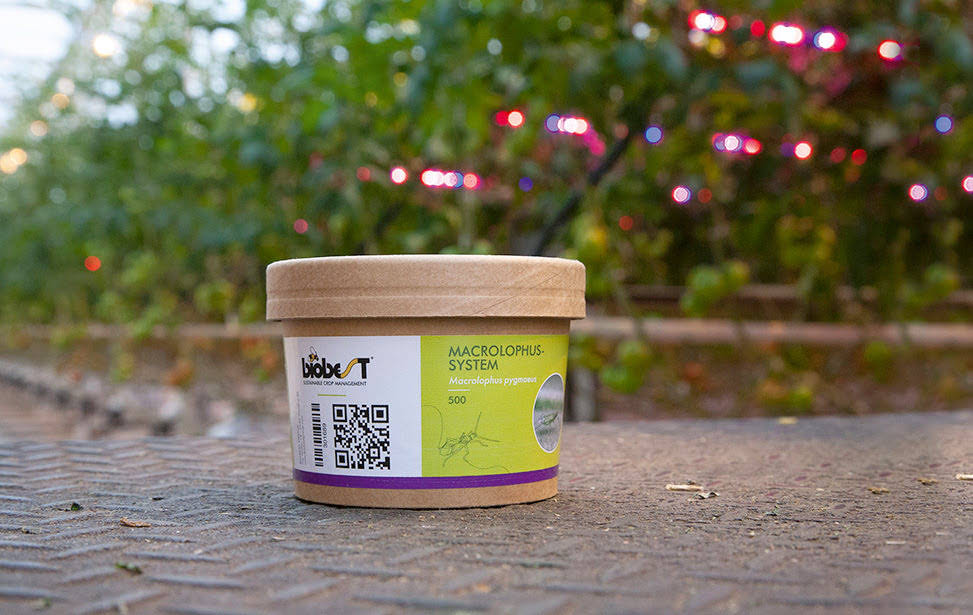- English

New and improved 100% biodegradable packaging for Macrolophus-System is delivering a raft of tangible benefits to growers across Europe. Following recent field trials in commercial tomato crops in Belgium and the Netherlands, showing impressive improvements in Macrolophus pygmaeus establishment, growers across Europe are starting to see the benefits for themselves.
Redesigned to improve bug quality
The original Macrolophus-System plastic bottle, containing vermiculite carrier, has been replaced with a 100% degradable cardboard carton and removable lid. Inside, honeycomb paper helps protect the sensitive, delicate winged mirid bug, while a gel formulation provides water for the adults during transit.
Dutch truss tomatoes
Zadelaers Boogaerts Nurseries, in Naaldwijk the Netherlands, grows Trovanzo large truss tomatoes in unlit greenhouses totalling 11ha. Co-owner Vincent van Niel says; “The Macrolophus adults emerge faster and more energetically from the new packaging, spreading quicker throughout the greenhouse – helping deliver good control.
“This year we introduced Macrolophus-System at a rate of 2.5 per m2 in a single row per bay. We removed less leaf in these release rows to optimise nymph development. Immediately after release, we full-field feed with Artemac™ at 1 kg/ha.
“With Encarsia-System introduced in several places, Macrolophus has kept the whitefly under control without other interventions. We welcome the fact the redesigned packaging is 100% biodegradable – while it is positive to minimise plastic usage, it simplifies the waste stream.”
French glasshouse-grown tomatoes
Producing greenhouse tomatoes since 2009, Cheminant Group at Carquefou near Nantes has worked closely with Biobest sales representative Laëtitia Pacaud since 2010.
“We used to introduce Macrolophus-System in January using Bio-Boxes,” explains Cheminant’s Emmanuel Moreau. “In 2020, we decided to anticipate the pest with Macrolophus released in November.
“With the redesigned packaging, it takes 2-3 hours less time to introduce the predators per hectare. We simply open the pot and distribute the contents over the plants after applying Nutrimac™ in the release areas. We’ve noticed a marked improvement in the liveliness of the bugs – adults fly off into the crop as soon as the pots are opened. Subsequently we use Artemac™ to help maintain the entire greenhouse.
“With the new packaging the first generation appears about 10 days earlier, compared to the original packaging, and we delay deleafing until then. The population no longer remains synchronized and confined to release areas, we’re quickly seeing predators of all generations across the whole greenhouse. With improvements in the quality of the beneficials, we’re getting improvement in the quality of population build-up in the greenhouse.”
Hungarian classic tomatoes
At Flora 2002 at Ópusztaszer, near Karakas in Hungary, the classic variety Claudis is grown in high tech glasshouses.
“In the past we successfully established Macrolophus, but with the new improved packaging it is easier and faster,” says growing technician József Engi.
“Installing it is much simpler than the previous vermiculite-based system. As soon as we open the new sustainable cartons the predators are on their way, dispersing in the crop – they are much more active.
“I’m very satisfied with the performance – the Marcolophus is keeping down the whitefly as well as the Tuta absoluta, while the new environmentally-friendly packaging is an added benefit.”
Northern European season
With Macrolophus-System introductions now starting in crops in Northern Europe, growers there will be able to see for themselves how the redesigned packaging not only delivers a faster release but also improvements in bug activity, ease of installation and ultimately level of whitefly control. In addition, improvements in overall product sustainability – with the introduction of 100% biodegradable packaging – have shown to be of great value to the grower.
For tailor-made advice, contact your Biobest advisor.